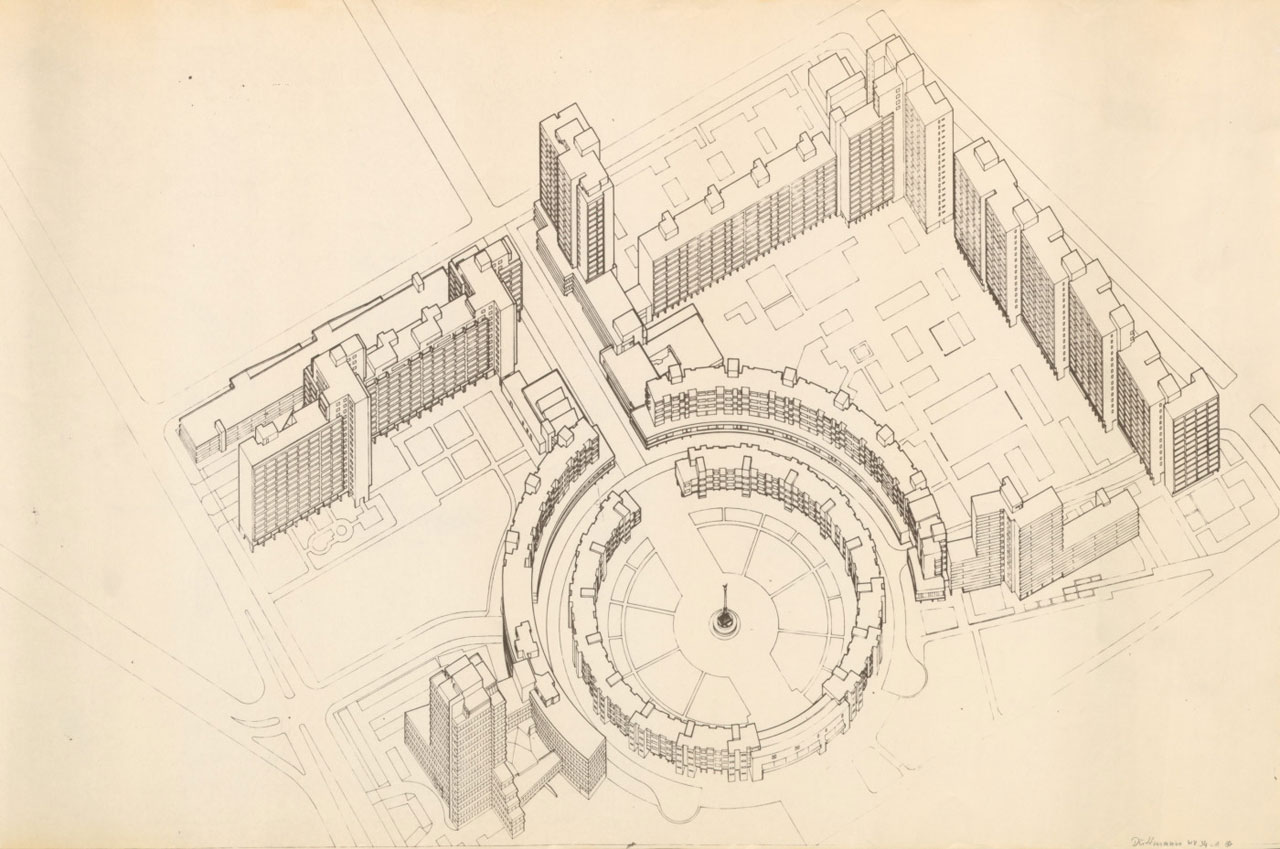
Berlin: The Living City of Autocracy—The Dead City of Democracy
How do you build a city? How can it be that our poor and barely literate ancestors were able to establish and build so many cities that worked so well throughout the ages, while we who live today, rich and well educated, so often fail when we try to do the same thing? Did our ancestors have a special talent, or did they have access to an archaic, passed-down, silent
knowledge that has been lost in some mysterious, magical way to all of us who live in our modern time?
No, it is not about the loss of a silent
knowledge. It is not about knowledge at all. We can learn this by studying how two of Europe’s most long-lasting, historically significant, and crucial political systems in our human development—autocratic monarchy and liberal democracy—each build their own Berlin in one and the same place. In both cases one began with the exact same physical conditions: in both cases one builds according to the same urban plan, with the same street layout, the same street widths, and the same urban spaces on the same flat, empty field.
This means that right here, in the Friedrichstadt district, one finds remarkably exceptional, laboratory-like conditions for a study of how cities function and grow (or do not function and grow): it’s as if it was always meant for the district to be wiped out and leveled to the ground by the carpet bombs of World War II, it’s as if someone got the idea that Friedrichstadt should be built as a full-scale laboratory, insulated from the world, in which one sought to ensure that all of the physical conditions in all of the district’s incarnations shall each time be exactly the same—so that one could later, in a laboratory-like way, be able to isolate the qualities of cities that (independent of the arbitrariness present in any given set of physical conditions) have the greatest meaning for a city’s growth, change, and development over time.
Let us search for answers to the questions brought up in the introduction by comparing the two historic incarnations of the Friedrichstadt district, the examples of Friedrichstadt before and Friedrichstadt now, and let us begin with Friedrichstadt in its first incarnation:
Europe. Prussia. Eighteenth century. That the city of Berlin shall be larger and more stately and extend out over the fields and lands to the west, outside the old medieval city walls and ramparts, this was decided long ago. An urban plan with straight streets at right angles had already been adopted. But this plan was never realized.
King Friedrich Wilhelm I, or Frederick William I as we usually say in English, eventually grows weary that nothing happens. In 1732 he sets into motion a remarkably ambitious urban expansion project. Berlin shall be twice its current size in ten years! Basta! and his subjects shall even foot the bill: the autocratic king simply gives the order that it is the Berliners themselves, at least the wealthy Berliners who are members of one of the city’s guilds (Gewerke), who—whether they want to or not, whether they believe they can afford it or not—shall build for themselves a new house in the new district.
But not just any ramshackle building: the central authority, it may be assumed, wanted to ensure that a least common denominator was in place in regards to construction and housing standards. Cheap construction and slums were to be avoided, so architect Philipp Gerlach was commissioned to draft plans for an unassuming stone building (two stories, seven windows across) that everyone must build from.
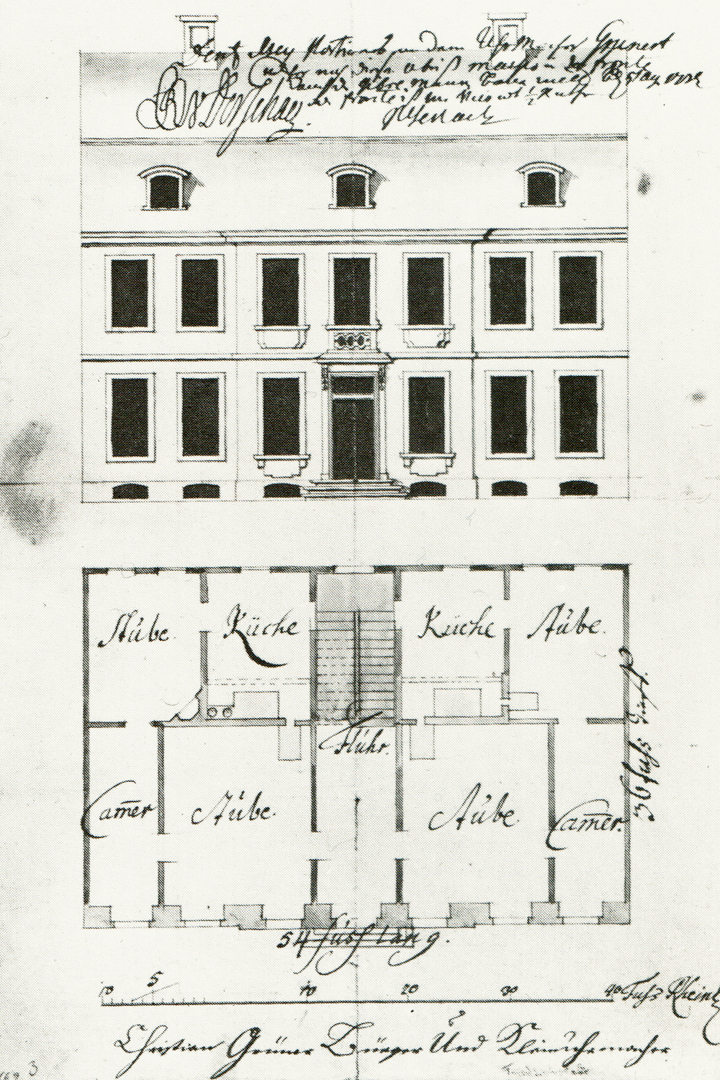
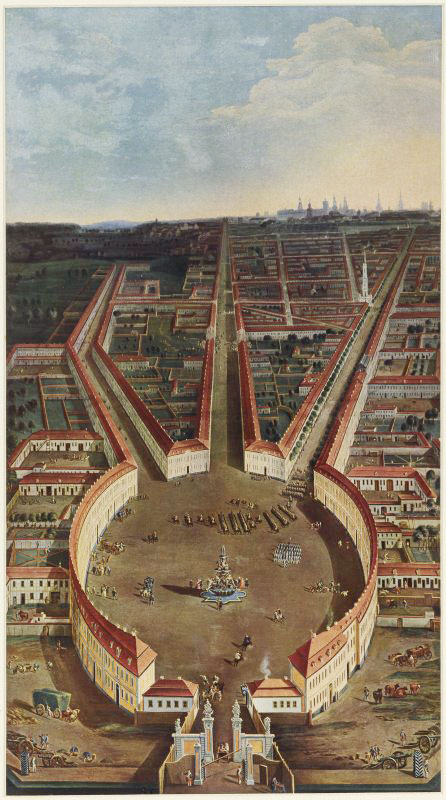
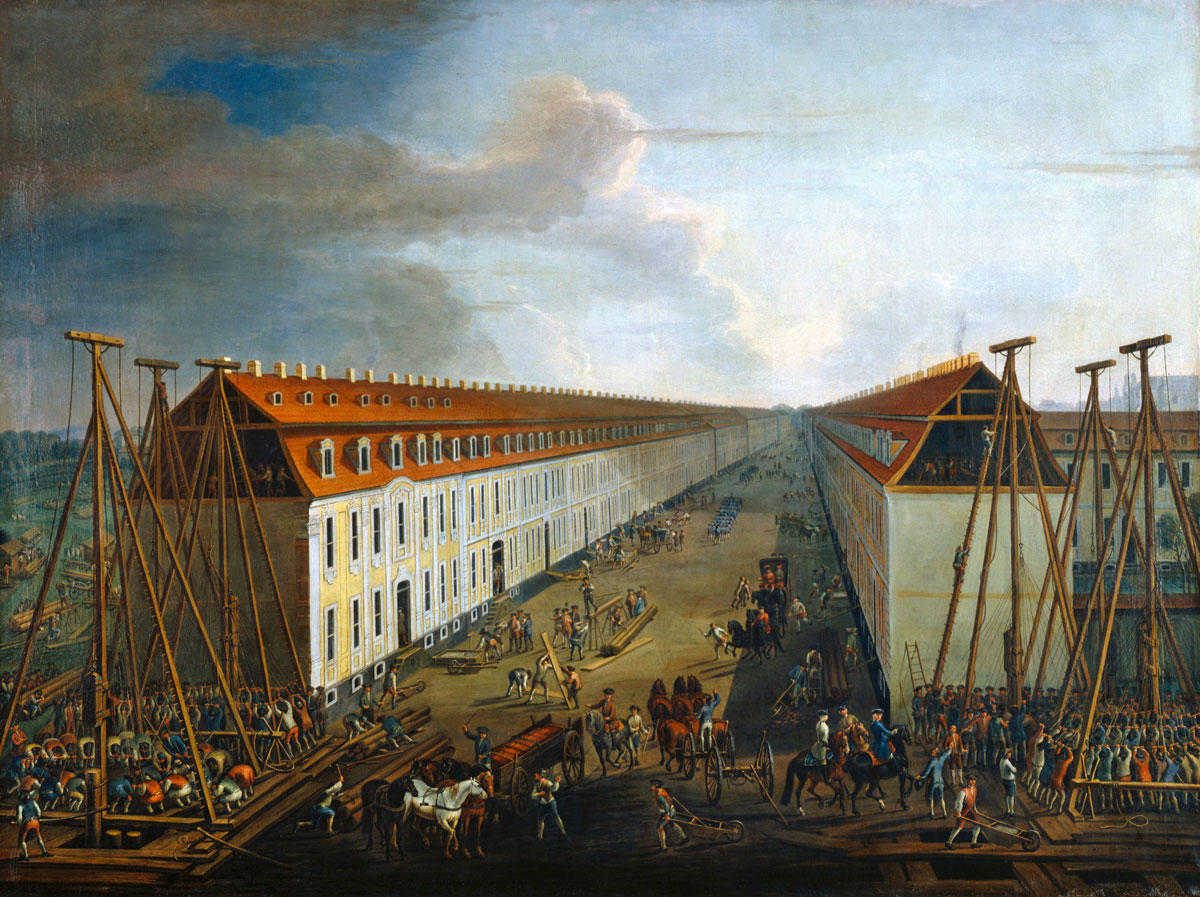
That the new Friedrichstadt was completed in 1738 is of course a fantastic achievement in several respects—in its scale as well as its level of ambition, comparable to Sweden’s Million Homes Program from the 1960s and 1970s.1
The project is reminiscent of 20th century suburban developments in other respects as well: the resulting townscape in its appearance and in its arrangement is stereotypical, monotonous, homogenous, and repetitious. All of the buildings that were constructed according to Philipp Gerlach’s drawings (in practice, the project’s building code
) look exactly the same. Moreover it is a decidedly sleepy suburban area: no shops, no grocery store, no service.
No native Berliner chooses willfully to move into the desolate district. The Old Town is where all of the shops and all of the entertainment venues and all of the services
are still to be found.
Frederick William has no patience with allowing people to move into the new area as they please, at their own pace, but instead—with a certain level of force and the help
of the military, one may assume—he simply makes one quarter of all the rental households in the old city center move there right away.
Suddenly all of the streets and buildings are populated and occupied. But it is still a rather dead
place. Despite the presence of three stylish market squares—one square-shaped, one octagonal, one circular—which were intended to provide the new residents with goods and services, these three geometrically distinct public places do not function as intended.
Nobody wants to sell their products at the markets there. The residents of the new Friedrichstadt must head to the market in the old town for their shopping, even after leaving.
The Living
City of Autocracy
Turns out however that not long after the area is inhabited, despite the architectural monotony and lack of service, the new district has the potential to be developed into something completely different and something completely new. The exceedingly homogenous urban landscape from 1738 eventually becomes highly varied. Few of the original two-story buildings remain in the end. Instead buildings of Parisian dimensions appear everywhere. People stroll under the linden trees on the wide boulevard Unter den Linden, and shop frantically on the narrow and intensive Friedrichstrasse. Traffic piles up every morning and evening at Potsdamer Platz. Everywhere there is life and movement in a culturally, commercially, and visually messy and heterogenous milieu. Through its own energy and without the involvement of the monarchy, the monotonous and unpopular dormitory suburb soon shows its potential to go through a veritable metamorphosis and resurrect itself as a living
district to the highest degree. After just a generation or so, the center of greater Berlin began its expansion to the west, which would soon transform these blocks into the new commercial, and not least, cultural center of the entire city.
How does this happen? How does the Friedrichstadt district go from a Million Homes Program
area to become the economic and cultural heart of Berlin?
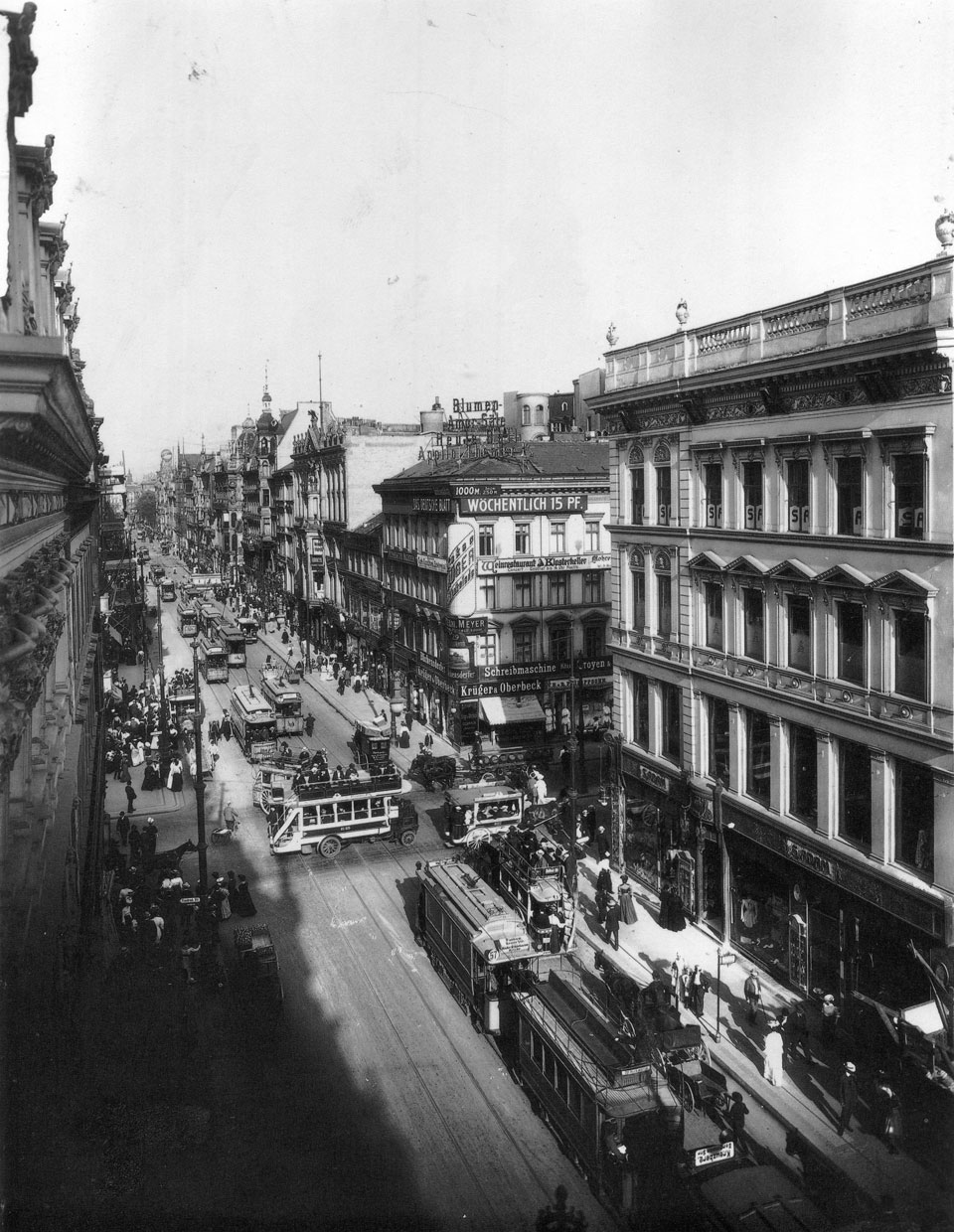
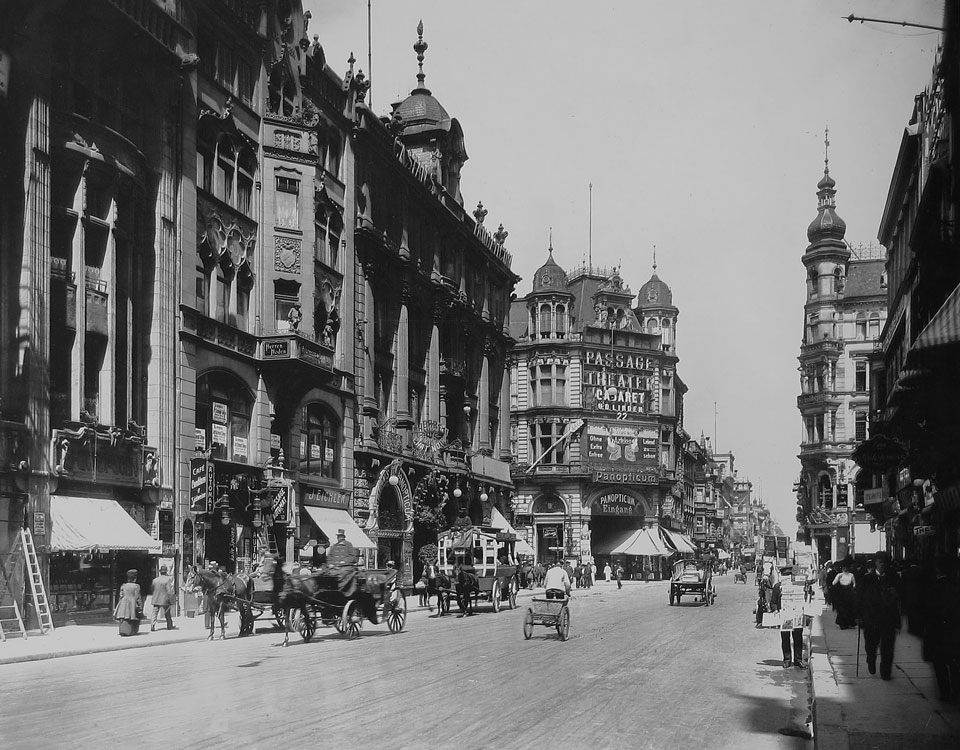
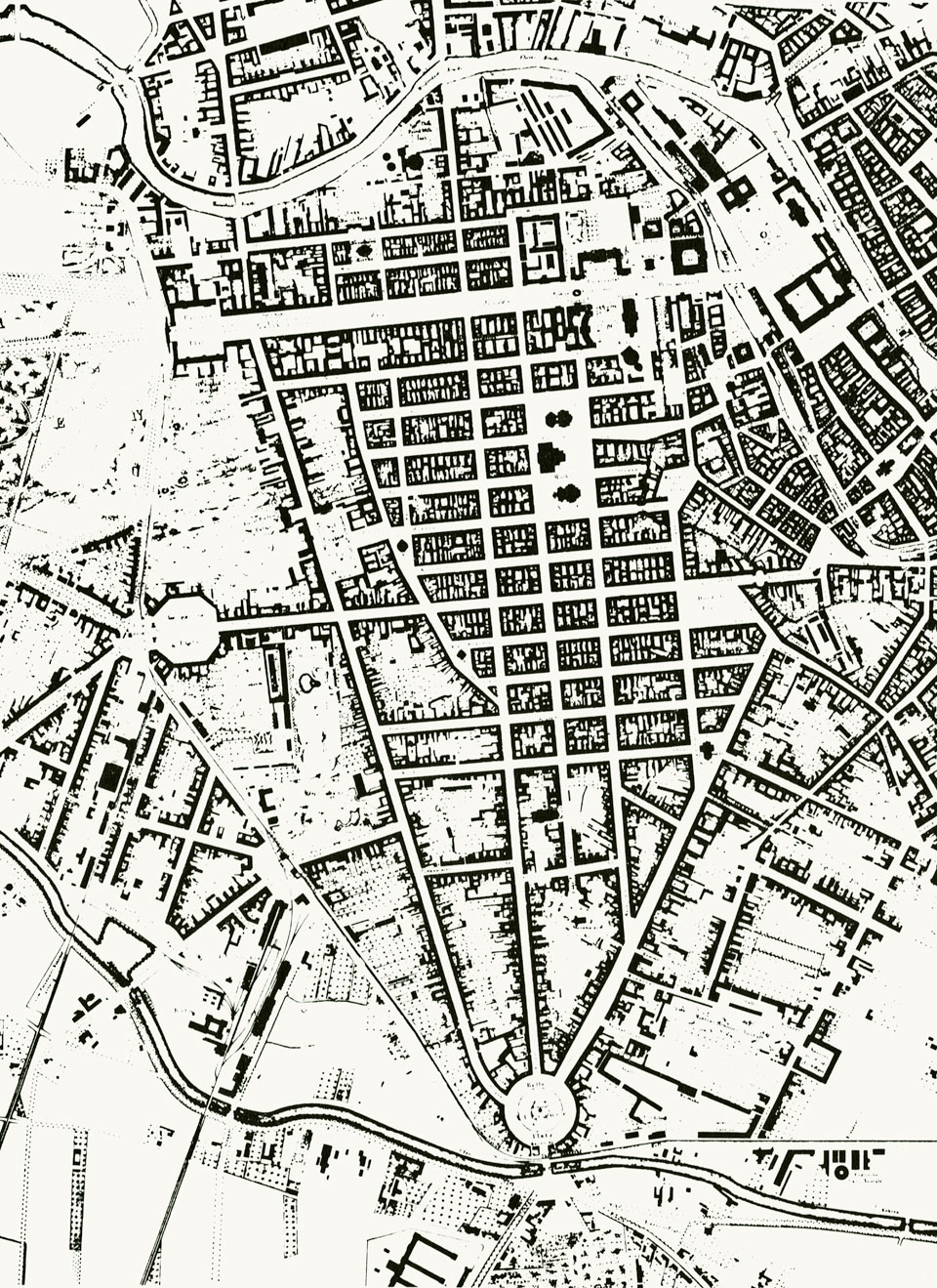


To begin with, one could imagine that the multiplicity of ownership and the fine mesh of property lines, along with the resulting financially manageable lot sizes for the bourgeois class, offered many opportunities for both middle class individuals and opportunist entrepreneurs to eventually embark on spontaneous initiatives to buy and sell, demolish and rebuild, build more and build taller.
Moreover, from the very beginning it was very easy to use commercial spaces anywhere in the district, for basically any type of business, due to the same measurements of the properties (all of the buildings were the same widths when first built), as well as the rational property divisions and (in the best sense) banal right-angles everywhere. A potential investor never loses precious time (or capital) by waiting for a suitably dimensioned or proportioned lot or space to show up on the market. When demand (commercial, cultural, social) does arise, there is probably always something on the market that would be of interest to an opportunistic entrepreneur. Anything can be built anywhere, and any business can be accommodated anywhere.
In addition, a regular grid of streets without cul-de-sacs ensures a continuous flow of traffic and the same customer potential throughout. For an opportunistic entrepreneur’s investment, each address is in principle as good as all of the others in a highly uniform city grid like this.
It is easy to imagine that these factors combine to create excellent conditions for Friedrichstadt to offer a long-term, financially dynamic and culturally productive milieu to the highest degree: a district where things happen
all the time.
The Dead
City of Democracy
But in the beginning of the nineteenth century Prussia is faced with major political upheavals. After the defeat at the battle of Jena-Auerstedt in 1806, the Germans were forced to follow the principles of the new Napoleon Code: the end of feudalism and the beginning of equality before the law.
Things did not of course change overnight in Prussia after the defeat in 1806 (or in the rest of Europe for that matter). But the major barriers to liberty and equality for all are at first mainly technological and economic: in the west, human rights, both morally and philosophically, are something one can afford only when the pace of rationalized agriculture, industrialization, the steam engine, and the combustion engine create an economic space that allows one to begin to empathize with and humanize the underclass.
But despite the technological and economic barriers and detours, when the modernization and democratic processes eventually get under way, they are by and large unstoppable—in Germany as well as in the rest of Europe.
Europe’s capitals, in step with this unstoppable social development, acquire a new important function: they must accommodate many newly established public institutions, and their often very lavish and monumental buildings. Which are built preferably at prestigious addresses in the city center.
To name a very obvious and visually clear-cut example of this process: on Île de la Cité—the island in the middle of the Seine that during the Middle Ages contains the entire city of Paris—gigantic, imposing institutional buildings are constructed. Especially the Palais de Justice, which grows ever larger and lays claim to ever more land. The institutional buildings on the island eventually gobble up so much land that the area appears ever more dead.
Not much happens
here any longer. No one goes to Île de la Cité; one goes over the island and past it. To the degree that things happen
in Paris, from around the middle of the nineteenth century it happens somewhere other than at Île de la Cité.
Similarly, in Stockholm (to give an example in Sweden), Helgeandsholmen and Södra Klara are fossilized
during the nineteenth century by the Parliament Building and the Central Bank Building, as well as palatial government offices and equally palatial commercial banks. In this respect, it is not the urban renewal of the twentieth century that actually killed
Södra Klara; this is accomplished instead by Sweden’s democratization in general, and, in particular, by the abolition of the Riksdag of the Four Estates (Nobility, Clergy, Bourgeoisie, and Peasantry) in 1865.
Even Friedrichstadt during the nineteenth century becomes more and more a district for Prussia’s new institutional buildings than for anything else. Just like the examples of Île de la Cité or Helgeandsholmen, the transformation is a direct consequence of social development: democratization = institutionalization.
2
Institutions, to ever greater degrees, squeeze out housing and privately owned commercial properties. Large establishments and complexes in turn demand the combining of multiple properties. The original very small parcels are too small for the state’s new giant complexes: combining parcels becomes a must.
But it doesn’t end with the district’s fossilization
and institutionalization.
On top of all that, Friedrichstadt in the final phases of World War II is almost completely leveled by the allies’ carpet bombs. The district is once again reduced to a tabula rasa: a flat and empty and dusty no-man’s-land on the border between the two powers of the cold war, just as flat and empty and desolate as it was before Frederick William began his sweeping development in 1732.
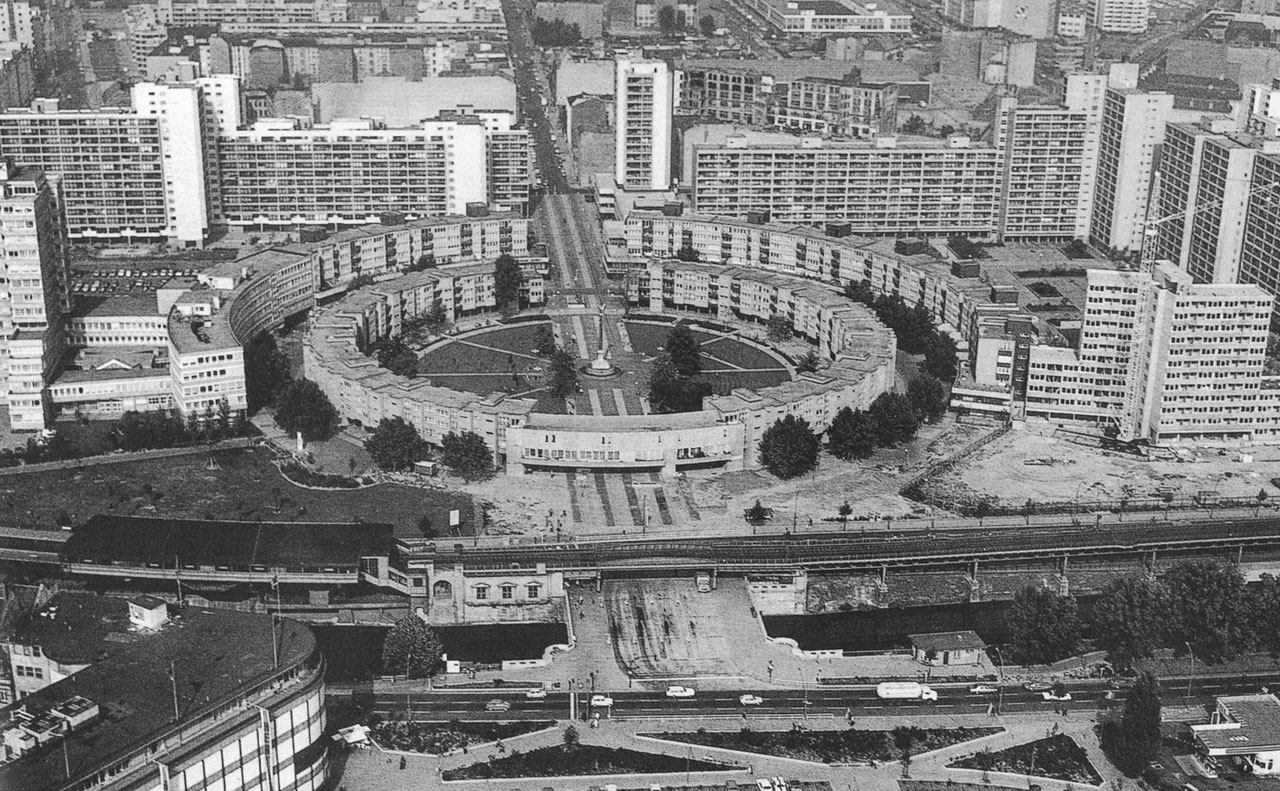
After the war years, initiatives to begin to rebuild the district eventually and slowly emerge. But—and this is a big but
—it turns out that the late-twentieth century could not offer the same exceptional conditions for a dynamic urban development here as the eighteenth century could. Today one may conclude, almost seventy years after the end of the war, that there still happens
very little here. Friedrichstadt is and remains principally an institutionalization
district. This is already the case when Schinkel builds the opera house during the nineteenth century. And is also the case during the Third Reich. And is still the case when less-than-appreciated housing complexes are built here during the 1970s and 1980s on both the east and west sides of the wall. This appears to even be the case for the future of the district—as witnessed by all of the brand new ministry buildings and embassies constructed after the fall of the wall.
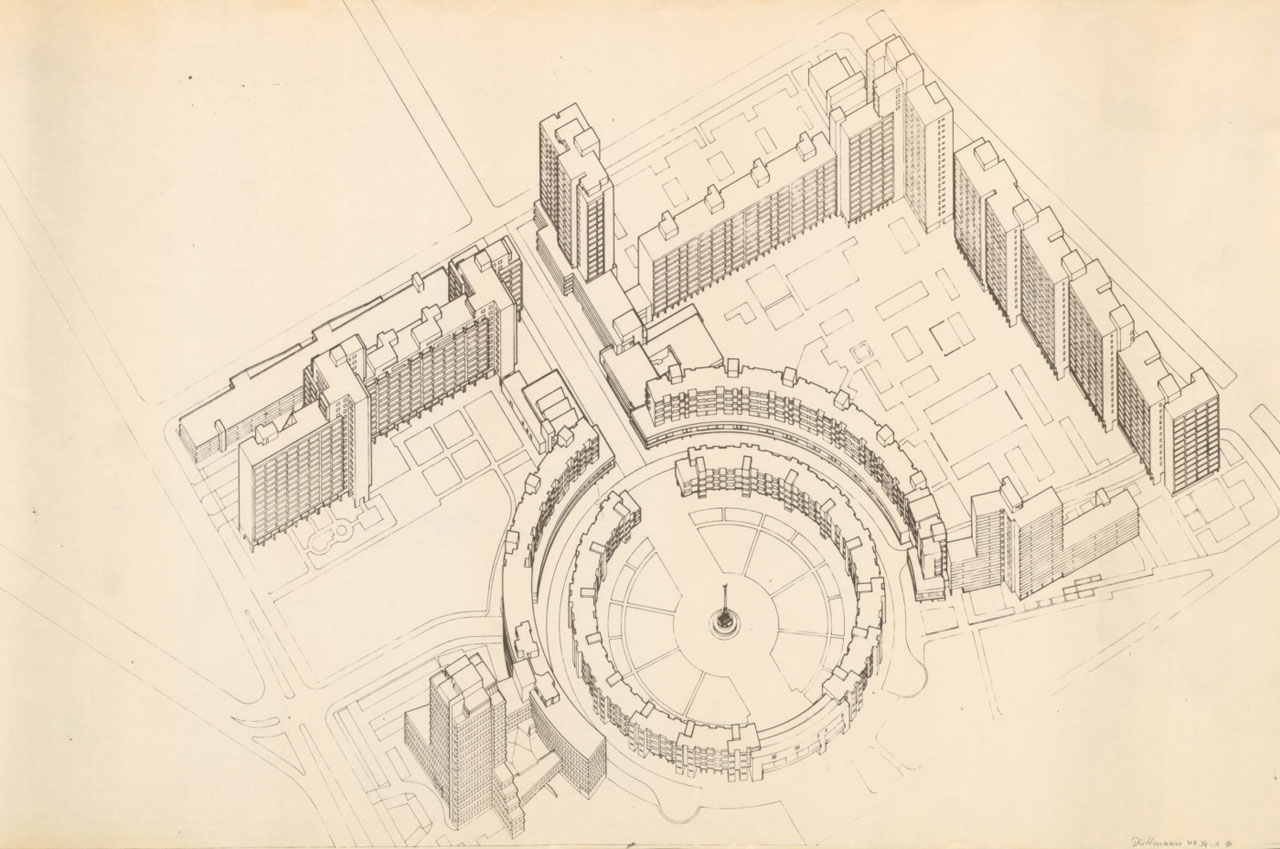

The oversized properties—much too large for entities other than the state, public services, or multinational corporations to manage financially—give few opportunities for smaller and mid-size entrepreneurs to take their own spontaneous initiatives in the property market. When demand (commercial, cultural, social) does arise to build something other than large-scale projects of one kind or another in Berlin, there is hardly any property in Friedrichstadt that could be of interest for the market, at least not for the smaller or mid-size investor. They will look elsewhere.
As a result, the conditions are unfavorable today for Friedrichstadt to be able to offer a dynamic and culturally productive environment in the same way it could 200 years ago. A general institutionalization
like that in Friedrichstadt leaves no breaks or pockets or gaps or cracks or other forms of space for the unexpected or the innovative. To the degree something happens
in Berlin today, something new,
it takes place somewhere else, not in Friedrichstadt. To the degree that Berlin today is a living
city, there are few signs of new life
here in Friedrichstadt.
But one would barely expect anything else in our time, in the age of globalized democratization. It’s the same way in Paris as it is in Stockholm and most of Europe’s capital cities since long ago: the inner city blocks, which from the beginning were the city’s most financially dynamic and culturally productive, tend to institutionalize
and fossilize
ever more, at the same pace as their respective nations gain success in equal opportunity and equal rights.
Power and Powerlessness
Without a doubt, the autocrat Frederick William demonstrates a great ability to take action as a city builder in Berlin during the 1730s. But still, the term autocrat
is misleading. No autocratic king exercises total
power as a single, individual person. An autocratic king is not able to exercise total
power over everything and everyone. When Friedrichstadt is completed in 1738, it is certainly the king who decides that the district should be built at all, and when and where, and how all of the buildings of the district shall appear in the smallest detail (exactly alike! every one!)—but it is not the king who owns the buildings or the properties that the buildings rest on. There are limits to how much power an autocratic king can claim in reality. Like for example how much private property an autocratic king can in the long run have the wherewithal to manage and take a personal, burdensome, time-consuming owner’s responsibility for: Friedrichstadt is mostly left alone by the monarchy, to be managed (and developed) by Berliners themselves after the king makes sure that the new district is inhabited and occupied.
When viewed as a system of power, autocracy is therefore (in opposition to what the term suggests) anything but total
or all-encompassing. Frederick William may certainly force people to construct new buildings whether they want to or not, whether they can afford it or not. But keep in mind everything he has no control over as well.
In truth, all kinds of despotic systems always have (and must always have) gaps,
where citizens are given space (with or without the approval of the leaders) to improvise—like in the black market of the dictatorship of the proletariat, for example.
In the long run no despotic system can survive without such gaps. In the long run no despotic system can survive by being total
in its exercise of power. When the autocratic despot is no longer content with just displaying varying degrees of arrogance and distance, and instead insists on total
power, then it is more the rule than the exception that he eventually also becomes increasingly paranoid. In the end, his desperate attempts to close all the gaps and cracks in the system will always be in vain. Sooner or later the totalitarian claims of despotism always become too heavy. The system implodes. Sooner or later all despotic totalitarian systems collapse, as we have seen on both the right and left sides of the political spectrum.
Only one political system has appeared that has the ability to exercise—and keep!—total
power. Only democracy (!) has the capacity to come even close to exercising the kind of comprehensive and total
power that one would otherwise believe that only autocratic and totalitarian despots could lay claim to. Through a comprehensive network of reciprocal feedback relations and mutual conditions of electoral trust between citizens, an entire population in a well developed democracy (ideally) takes mutual responsibility for everything and everyone, and at the same time has mutual power over everything and everyone—in a significantly more total
way than Frederick William ever had over Friedrichstadt, for example. To have total
control is so resource-intensive that an autocratic monarch or totalitarian tyrant, as a single individual person, can never hope to acquire it. Total
control is something that only a prosperous, well educated, self-governing people who take on a mutual financial and cultural and political responsibility for their own liberty can come anywhere close to. Only in a prosperous and highly developed democracy can there exist sufficient financial and political resources for a total
transparency and scrutiny and insight into the smallest gaps and slits in society, so that one may always correct and set a new course for whatever is going in the wrong direction, and in this way avoid all undesired and unpleasant surprises.
So even if modern western democracies are repeatedly challenged by totalitarian regimes (not least in Berlin!), they have always made a comeback. They could do this because over time they have managed to exercise a kind of all-encompassing, comprehensive total
power without breaks and pockets and gaps and cracks, and to do so in a stable way that no despotic regime can ever pull off—not even with the help of a nazi-drilled army or a Berlin Wall.
Conclusion
Back to the questions posed at the beginning of this text: did our forefathers have a special talent, or did they have access to an archaic, passed-down, silent
knowledge that got lost in some mystical, magical way for all of us who live in our modern time? What can we learn from a comparison of Friedrichstadt before and Friedrichstadt after?
The Friedrichstadt of the eighteenth century would develop into an economically and socially and culturally productive urban milieu all at the same time, not because eighteenth century planners knew better than we do about how to make this happen,
but rather because it could not end in any other way: the autocratic king, out of political and economic necessity, was forced to refrain from having total control over the district’s real estate, which left the field wide open for the opportunism of private entrepreneurs in a way that would be politically impossible today: a consequence of property lines, regulations for the formation of properties, and the size of the properties. Friedrichstadt from before teaches us that in order to advocate for the preservation of those living
urban environments that still remain in our cities, a good slogan would be The Good Property
or The Good Process of Property Formation.
Friedrichstadt of the twentieth century instead became highly institutionalized,
with, in the best case, either economically or socially or culturally productive institutions and complexes spread out over the area—and once again, this took place because it could not have ended in any other way: today’s Friedrichstadt teaches us that to the degree our modern western metropolises still have living
urban districts that continue to thrive, the underlying conditions for these areas were probably created by despots and tyrants—not by democrats.
Berlin: enväldets levande och demokratins döda stad
Development of Friedrichstadt in the Age of Absolutism (1732–1738),in the catalogue/project presentation published by Quadriga Verlag Berlin in 1981 for the International Building Exhibition (IBA) in Berlin 1984. Also of interest is the following contribution to contemporary history by Mats Fahlander:
Berlin, augusti 1996,in the architecture magazine MAMA (Magasin för Modern Arkitektur), Stockholm, no. 15-1996.
Ett Stockholm vid historiens slut
The Trouble with the St. Erik’s Housing Estate
What System Will Save Us Now that Democracy Won’t?
Illustrations
• Standard designs for Bürgerhäuser (town houses) in Friedrichstadt, 1732 by Philipp Gerlach. Image source: Landesarchiv Berlin. Senator für Bau- und Wohnungswesen – Landesconservator. From the exhibition catalog of the Internationale Bauausstellung (IBA) Berlin (International Building Exhibition Berlin), Quadriga Verlag (1981).
• Hallesches Tor, Rondell/Rondel/Rondeel (later Belle-Alliance-Platz, now Mehringplatz), Wilhelmstraße, Friedrichstraße and Lindenstraße—an idealized bird’s-eye view. Artist: Dismar Degen, court painter at the Prussian court (1734). Image source: Wikimedia Commons. Staatliche Museen zu Berlin.
• New houses are being built along Friedrichstraße at breakneck speed—all of them exactly the same, in accordance with a standard design by architect Philipp Gerlach. Artist: Dismar Degen, court painter at the Prussian court (1735). Image source: Wikimedia Commons. Stiftung Preußische Schlösser und Gärten Berlin-Brandenburg, Schloss Königs Wusterhausen.
• Leipziger Straße at the corner of Friedrichstraße, Berlin. Unknown photographer (1907). Image source: Wikimedia Commons.
Friedrichstraße at the corner of Mittelstraße, Berlin. Foto: Waldemar Titzenthaler (1909). Image source: Wikimedia Commons.
• South Friedrichstadt, Belle-Alliance-Platz (today Mehringplatz), aerial photo (1935). Image source: Landesbildstelle Berlin. Google Arts & Culture.
• Ernst Ludwig Kirchner: Belle-Alliance-Platz in Berlin (1914). Neue Nationalgalerie, Berlin. Photo: Mikael Askergren.
• Berlin city map by T. Sineck (1856). Image source: Berlin-Museum. From the exhibition catalog of the Internationale Bauausstellung (IBA) Berlin (International Building Exhibition Berlin), Quadriga Verlag (1981).
• Bombed-out Berlin.
• Mehringplatz. Isometry of the Residential Building, blueprint, AdK, Düttmann 455 Pl. 34. Architects: Hans Scharoun, Werner Düttmann (1966-1975). Image source: wernerduettmann.de
• Aerial View of Mehringplatz in the Direction of Friedrichstraße, in: H. Ochs, Werner Düttmann, photo: Günther Krüger. Image source: wernerduettmann.de
Footnotes
Institutionalizationand its variants are used here to approximate the intended meaning, even though large-scale housing or commercial complexes may also fall into this category.